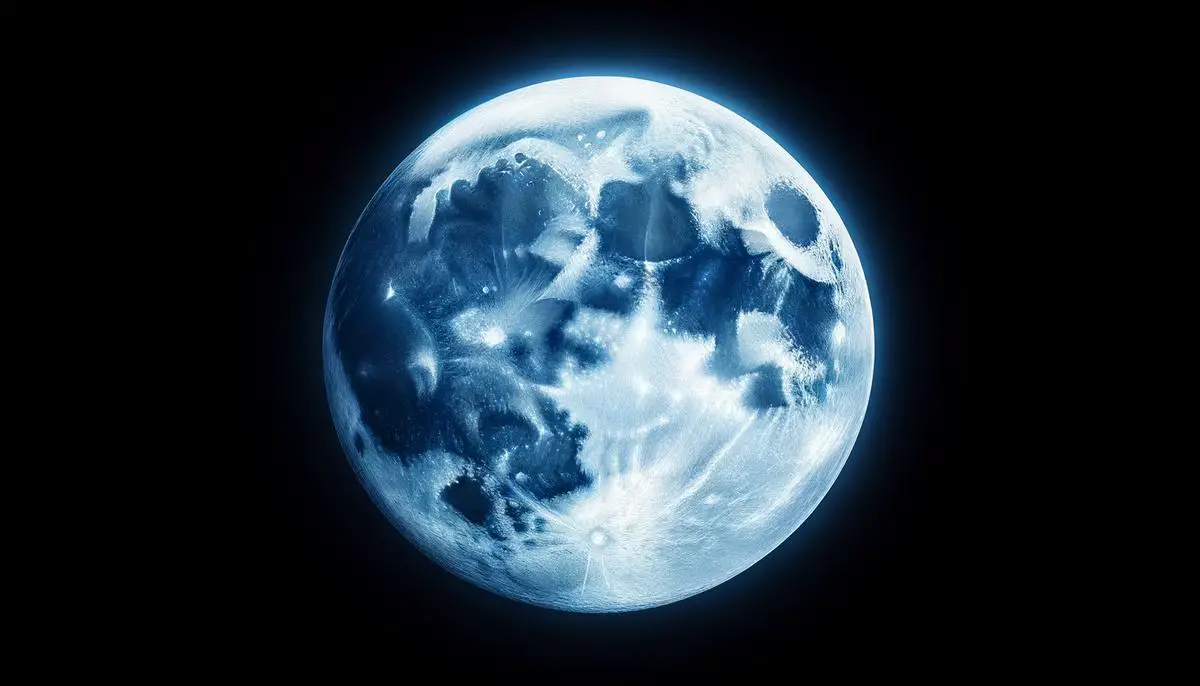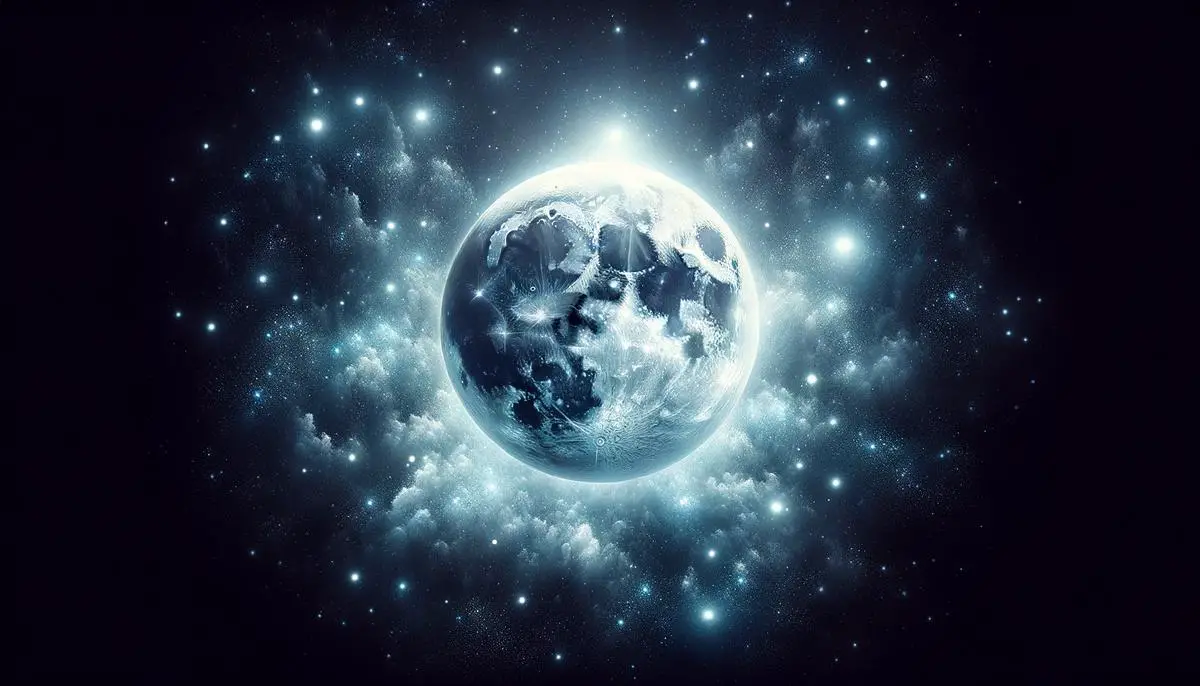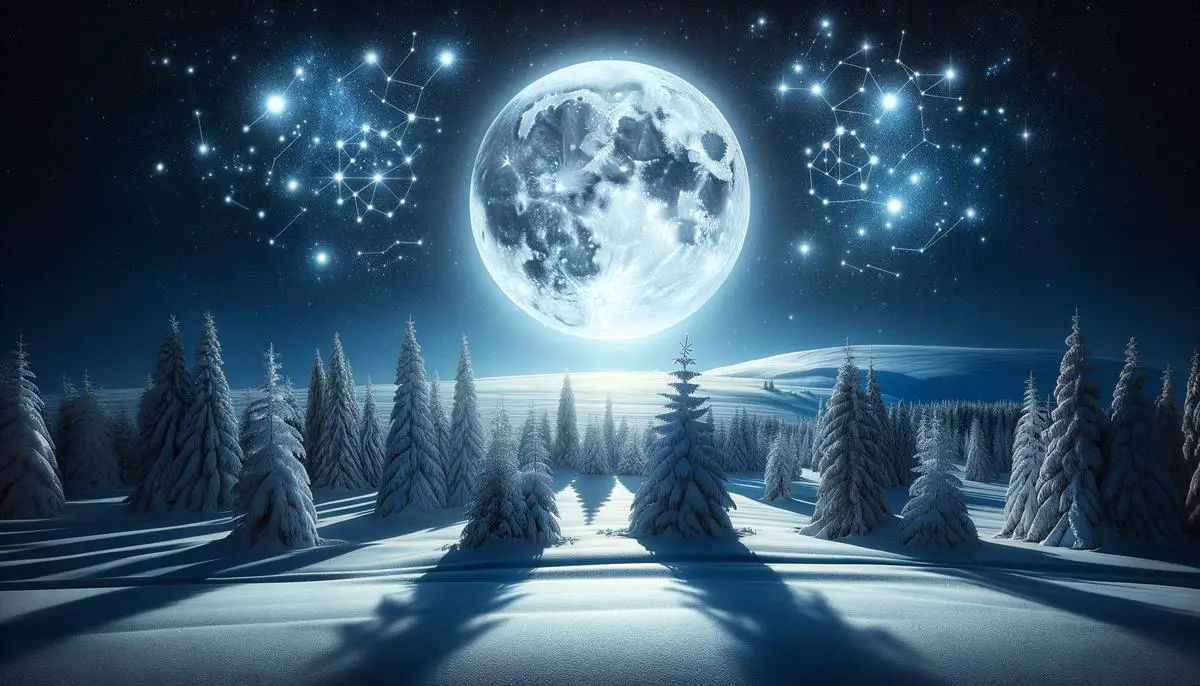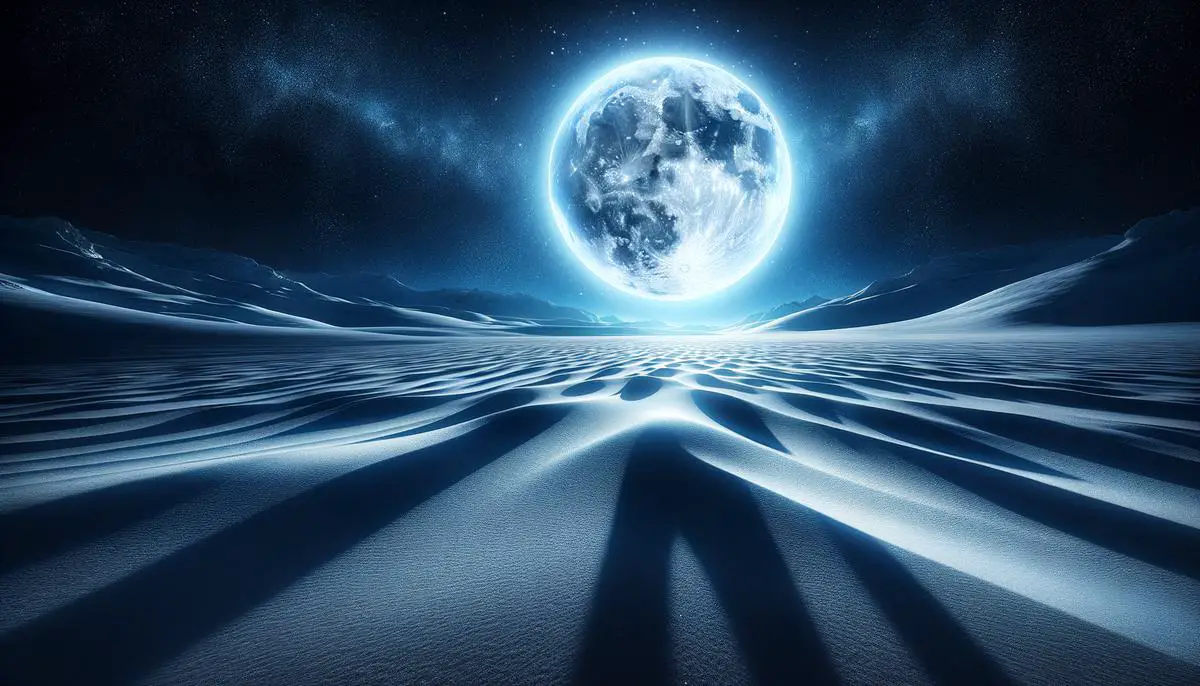When the winter sky is painted with the silvery glow of the full moon, it’s time to gaze upon the Snow Moon. Rich in cultural history and celestial wonder, the Snow Moon stands as a beacon in the night, guiding us through the closing days of the season. Whether it’s weaving through the tapestry of Indigenous American traditions, twinkling with astrological significance, or casting its steady light into the scientific realm of astronomy, this lunar marvel captures our collective imagination. As we uncover the layers of its significance, from the spiritual to the psychological, we gain a deeper appreciation for this monthly spectacle and its place in the natural world.
Cultural and Historical Significance of the Snow Moon
The Snow Moon: Unveiling Historical Beliefs and Cultural Narratives
Every year, as winter holds the Northern Hemisphere in its icy grip, a spectral orb ascends the night sky. This is the Snow Moon, February’s full moon, parading a tale older than the written word. Societies from bygone eras, diverse in customs and separated by vast oceans, have gazed upon this moon, weaving it into the fabric of their cultural tapestries. In this exploration, we illuminate the connection between the Snow Moon and the rich tapestry of historical beliefs and cultural narratives.
What’s In a Name: The Etymology of the Snow Moon
The term “Snow Moon” is nurtured from Native American traditions. Many tribes named the lunar cycles as a way to track time, each moon correlating with a natural event or seasonal change. The Snow Moon earned its moniker due to February’s heavy snowfall, blanketing the earth in silence and white. Algonquin tribes in the northeastern United States are often credited for assigning this wintry name, though variations existed across the continent.
Beyond America: Global Moon Lore
Cultural tales from around the globe echo similar sentiments. Far from America’s shores, in Europe, some referred to this moon as the “Storm Moon” or the “Hunger Moon,” highlighting the harsh climactic conditions that could impede travels and deplete food stores. This nomenclature reflects a collective human acknowledgment that nature’s cycles are inextricably linked to human survival and society’s rhythm.
The Spiritual Connection: Myths and Rituals
The Snow Moon also sails on spiritual seas. Historically, its arrival was often seen as a time of purification, a celestial signal to prepare for the reawakening of the earth. Some cultures performed rituals to cleanse the spirit, making way for the renewal that arrives with spring. In some Native American tribes, the Snow Moon was a moment to enact the forgiveness and purging customary to the welcoming of new life.
Astrological Implications: An Astronomer’s Dream
Astrology, a discipline hatched from astronomy’s nest, has also graced the Snow Moon with significance. Many believe that the cosmic energies released during the full moon phase exert influence over human behaviors and emotions. The Snow Moon, swaddled in winter’s stillness, has been characterized as a time of introspection and inner healing.
Snapshots in Time: Historical Events
The passage of the Snow Moon has also coincided with noteworthy historical events, anchoring it in collective memory. Some anecdotes recount significant snowstorms or natural occurrences that aligned with its ascent, reinforcing the name and embedding these lunar observations into cultural and historical conscience.
Connecting to Today: Modern Celebrations
In the ever-spinning modern world, fascination with the full moon persists. Astronomers and amateur stargazers alike revel in the magnificence of the Snow Moon. Its annual appearance is a reminder of the celestial gears that turn seasons and lives. Today, people host gatherings, engage in meditation, and indulge in photography under its glow, connecting contemporary practice with an ancient human penchant for lunar lore.
In Conclusion
The Snow Moon, with its refulgent glow, does more than just pierce the night’s veil. It is a celestial historian, carrying with it stories of survival, spirituality, and society from timeless cultures. As we continue to navigate the complexities of our own time, the Snow Moon serves as a luminous thread, connecting us with the human narrative that is as old as the stars themselves. Gazing upon it, we are reminded of our shared history and the cyclical nature of our existence, where every end is but the prelude to a new beginning.
So, as the Snow Moon climbs above the horizon this February, peer through the lens of the past, and see not just a moon, but an echo of humanity’s journey through the cold, starry sea of time.

Astrological Perspectives on the Snow Moon
Delving deeper into the insights of astrologers regarding the Snow Moon, one unveils a celestial spectacle rich with symbolic resonance. This wintry moon phase, named for the often snow-laden month of February in the Northern Hemisphere, carries with it a unique significance that astrologers interpret through a cosmic lens.
Astrologically, the Snow Moon is a time when the veil between the conscious and unconscious mind thins, inviting a period of introspection and illumination. As the full moon casts its bright glow upon the earth, astrologers see this as an opportunity for individuals to shed light on the shadowy corners of their inner selves.
Astrologers often suggest that the energy of the Snow Moon amplifies emotions, bringing them to the surface like a cresting wave. This can manifest as heightened sensitivity in personal relationships, perhaps causing tensions to flare or buried sentiments to burst forth. However, this same intensity can be channeled towards healing, offering a chance to clear emotional blockages and foster a deeper connection with oneself and others.
In terms of life direction and purpose, the Snow Moon is seen as a guiding beacon, prompting reflection on one’s path. Astrologers believe that this lunar phase can provide clarity, helping individuals to discern their true desires and ambitions from the fleeting whims of daily life. It’s a celestial invitation to reevaluate goals and realign with one’s core intentions.
Furthermore, astrologers often speak to the Snow Moon’s potential to initiate change and transformation. They advise that this period is ripe for setting intentions and launching new projects, as the full moon’s energy is at its peak, providing momentum.
When it comes to the zodiac, each Snow Moon interacts with the astrological signs differently, infusing the period with specific themes and lessons. For example, if the Snow Moon occurs in Leo, it might emphasize self-expression and creativity, urging individuals to step into the spotlight and share their unique gifts. Conversely, a Snow Moon in Aquarius might stress collective well-being and innovation, encouraging breakthroughs for societal benefit.
On a broader scale, astrologers regard the Snow Moon as a symbol of the cyclical nature of life. Just as the seasons ebb and flow, humans, too, experience phases of growth, dormancy, and rebirth. This lunar event is a reminder of the impermanence of life’s challenges and the promise of rejuvenation that follows.
In modern practice, individuals might harness the energy of the Snow Moon through personal rituals such as meditative journaling, a focused reflection on one’s accomplishments and setbacks, or a simple mindful walk under the moonlight to absorb its influence.
In essence, the insights astrologers offer on the Snow Moon paint a portrait of a time brimming with potential: for inner discovery, for the healing of past wounds, and for planting the seeds of future endeavors. It is a celestial guidepost steering the collective and the individual through the perennial journey toward enlightenment and growth. And as one immerses in the glowing aura of the Snow Moon, astrologers counsel a heart open to change, receptive to the whispers of the universe.

Astronomical Aspects of the Snow Moon
As we venture into the celestial features of the Snow Moon, we realize there is a unique tapestry interwoven with astronomical specificity. The Snow Moon is the full moon that typically graces our winter skies in February; this is when the snow blankets the ground in many regions, painting a serene, frosty landscape.
The Snow Moon’s orbit and visibility are areas ripe for exploration. When we cast our eyes towards the night sky during this phase, the Snow Moon often seems notably bright and large. Its luminosity is not merely a trick of the eye but is partially due to its trajectory. The moon’s path during this period brings it to a point that is quite close to Earth, a position known as perigee within its elliptical orbit. As a result, the Snow Moon might look extra magnificent, lighting the cold winter night—a phenomenon some refer to as a “Supermoon.”
Let’s delve into the timings and visibility conditions. Timing, for the Snow Moon, is a fascinating subject. The full moon phase happens when the moon is positioned directly opposite the sun, with Earth in-between. This precise alignment allows the moon to appear fully illuminated from our perspective. For the Snow Moon, this happens in February, aligning with many traditions and the heart of winter in the Northern Hemisphere.
The temperature and atmosphere during these winter months can affect how we view the Snow Moon. Cold air tends to be drier and clearer compared to the warm, humid air of summer, providing an unhindered view of the moon. Additionally, because the nights are longer in the winter, the Snow Moon may ascend higher in the sky, offering a clearer and more commanding presence.
Alas, the Snow Moon not only beguiles us with its brightness but also through its color and texture. On nights when the atmosphere is loaded with moisture or fine particles, the Snow Moon can adopt an orange or reddish hue as it rises or sets. This happens because, at a low angle, moonlight passes through thicker layers of Earth’s atmosphere, which scatters the shorter, bluer wavelengths and lets the longer, redder wavelengths dominate.
The Snow Moon’s size and brightness can be quantified in astronomical terms. To measure brightness, astronomers refer to a value called magnitude, while its apparent size is discussed in terms of angular diameter, measured in arcminutes or arcseconds. For the casual observer, these figures help to understand the Snow Moon’s grandeur during its full phase.
Circling back to the moon’s effect on Earth, the gravitational pull of the Snow Moon is particularly impactful. It can result in higher tides, called spring tides, which are more pronounced due to the moon’s closeness during the full phase. These tides remind us of the celestial dance between Earth and its satellite—a rhythmic sway that has fascinated humanity throughout time.
In understanding the astronomical characteristics of the Snow Moon, we gain a deeper appreciation for the cosmic forces at play. When we observe the Snow Moon ascendant in the February sky, we’re not only witnessing a monthly occurrence but participating in a storied, celestial phenomenon – one that has a profound impact on our planet and cultures across the world.
Take the opportunity to observe the Snow Moon in all its splendor. Note its position in the sky, its unique glow against the tranquil winter backdrop, and the serenity it seems to bestow upon the Earth below. This is a time to revel in the wonder of the cosmos, where each full moon brings its own tale, and the Snow Moon offers an icy but gentle narrative in the chill of February skies.

Spiritual and Psychological Implications of the Snow Moon
The Snow Moon, a luminous presence during February’s brisk evenings, casts a reflective silver glow across the winter landscape—a celestial spectacle that has long intrigued and influenced the human psyche. Let’s unravel how this radiant orb harmoniously intertwines with our spiritual essence and psychological framework, shedding light on its profound connection with our innermost selves.
Connecting to Our Spiritual Core
Bathed in the Snow Moon’s ethereal light, many people sense a magnetic pull towards introspection and spiritual awakening. It’s as though the moon’s luminescence acts as a mirror, reflecting our hidden depths and urging us to explore the contours of our soul’s terrain. Meditation and contemplative practices become more potent under its watchful eye, as we delve into the recesses of our spirituality, seeking a greater connection with the divine and the universe.
The Snow Moon, resplendent in its wintry crown, thus facilitates a spiritual journey of self-discovery and inner alignment. Its gentle illumination encourages us to tap into intuitive wisdom, fostering an environment where spiritual insights can emerge with clarity and resonate within our being.
Illuminating the PsycheCradled in the arms of winter, the Snow Moon also shines a light on the psychological landscape of our lives. During this phase, as our surroundings lay still under a blanket of snow, our thoughts and emotions often simmer to the surface. This time of year is known for heightened introspection—when we ponder the past, assess our current paths, and map out future endeavors.
The lunar glow, silent and serene, invites us to a quietude rarely afforded in the hustle of day-to-day life. It’s an opportunity to listen to the whispers of our psyche, to understand our deepest desires and confront our lingering fears. This understanding imparts a sort of mental clarity, enabling us to approach our lives with renewed vigor and purpose.
Fostering Emotional ResonanceEmotions, like the tides, ebb and flow, influenced by the gravitational force of the Moon. In the presence of the Snow Moon, this emotional tide tends to rise, amplifying feelings that may have lain dormant or muted by daily distractions. This lunar phase gives permission for emotions to spill forth, for tears to fall like snowflakes, and for laughter to ring out like a chorus of winter birds.
As we welcome the full force of our emotions, we also learn to navigate them better, to ride the waves with grace rather than be swept away by them. The Snow Moon, therefore with its introspective glow and emotional resonance, can guide us through the complexities of our emotional seas, teaching us about the strength and subtlety of our feelings.
Channeling Lunar Energy for Personal GrowthHarnessing the energy of the Snow Moon can be invigorating and transformative. By channeling this celestial force through personal rituals—be it a moonlit walk to clear the mind, journaling by candlelight, or simply standing beneath the night sky to absorb its vibrations—we inaugurate a space for personal evolution and healing.
The Snow Moon is a fortuitous time for setting new intentions, much like planting seeds deep in the winter earth, ready to burst forth with life at spring’s touch. It’s a period of laying the groundwork for future endeavors, nourishing dreams, and fostering aspirations, all under the watchful eye of this radiant night guardian.
In conclusion, the Snow Moon’s majestic presence in February is far more than a mere atmospheric phenomenon; it’s a catalyst for spiritual exploration, psychological insight, and emotional resonance. As we embrace the myriad ways it dances with our soul and mind, we can uncover new layers of meaning in our lives and uncover pathways to personal fulfillment and growth.

As we take a step back and admire the majesty of the Snow Moon, it reflects back to us a myriad of meanings and messages. This wintertime celestial event stands as a symbol, a guidepost, and a mirror to our innermost thoughts and feelings. It teaches us to embrace the quiet cold, to find brilliance in the stillness, and to remember that even in the depth of winter, the warmth of understanding and connection is never too far away. As the Snow Moon wanes and gives way to the next lunar phase, it leaves behind a trail of wisdom for those who seek to understand the complexities of the heavens above and the heart within.
![]()
